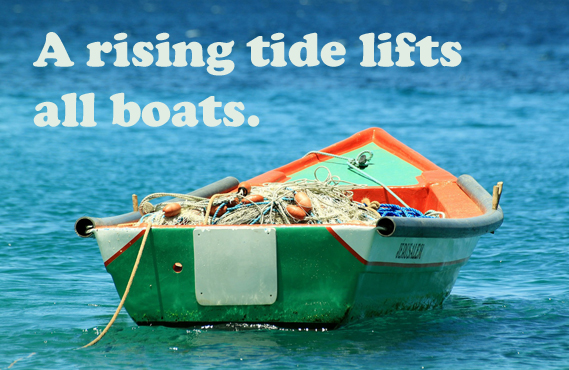 A rising tide lifts all boats, as the old saying goes. What does this mean in an education and human development context?
A rising tide lifts all boats, as the old saying goes. What does this mean in an education and human development context?
Eastside Pathways was founded to ensure that each and every child thrives from cradle to career. A focus on equity has been baked in since the beginning, in recognition of the unique challenges facing some of our learners more than others. As reported last month, the partnership has undertaken racial equity as a specific area of work through the Eastside Pathways Racial Equity Team. This matches an equity focus at many partner organizations.
A common objection raised whenever an organization or community focuses on equity is that if a disadvantaged group is getting additional attention or resources, then the more advantaged group will get less.
That argument is a red herring. Equity is not a zero sum game.
Instead, equity can mean looking at a system through the lens of its most disadvantaged members. Whatever is not working for them may well be impacting others in the system—just not as severely. The changes that improve their experience of the system will very likely feed up to others.
A recent article by Angela Glover Blackwell illustrates this beautifully. In The Curb-Cut Effect, she uses the example of how disability rights advocates improved accessibility for everyone by pushing for curb cuts, those flattened areas of sidewalk that slope down gradually to the street.
The initial argument for curb cuts came from people with disabilities, especially those in wheelchairs for whom a raised sidewalk was more than an inconvenience: sidewalks interfered with their ability to go about their daily life. The degree of disadvantage they faced compelled them to advocate for change.
As curb cuts were finally installed around the country, Glover Blackwell writes, “a magnificent and unexpected thing happened”:
When the wall of exclusion came down, everybody benefited—not only people in wheelchairs. Parents pushing strollers headed straight for curb cuts. So did workers pushing heavy carts, business travelers wheeling luggage, even runners and skateboarders. A study of pedestrian behavior at a Sarasota, Fla., shopping mall revealed that nine out of 10 “unencumbered pedestrians” go out of their way to use a curb cut.
This is what it looks like when a rising tide lifts all boats. Policies designed for the equitable access of one group opened the door to improved access for all, including those who were never impacted enough by the problem to have bothered to fight it.
* * *
At Eastside Pathways, our collaboratives have adopted this same mindset when looking at how to work together to enact systemic change.
The School Readiness collaborative knows that finding, accessing, and paying for high-quality early learning opportunities is a challenge for many families. Past projects have targeted support to families in public housing and Spanish-speakers at a local apartment complex, seeking to understand their experience in order to remove barriers to access for all families.
Similarly, the Summer and Extended Learning collaborative is familiar with the challenges in finding good summer programming due to the wide range of costs, application deadlines, and program schedules. Their work to make sign-up easier for families is done with the needs of working parents, speakers of other languages, and those with lower financial resources in mind. The resulting changes will streamline access and improve transparency community-wide.
The Attendance collaborative implemented a tardiness campaign to address the finding that frequent tardiness was correlated with lower proficiency on third grade reading. The first few years of the campaign resulted in a nearly 30 percent decrease in tardiness districtwide, benefiting a much larger population than just struggling readers.
The Transitions collaborative is looking at how to support students who get the most off-track after transitioning into middle or high school, as indicated by chronic absence, suspension/expulsion, or failing math or English. The program and policy changes they are considering will help smooth this difficult transition point for all adolescents.
The Career Pathways collaborative is developing a pilot to combat “summer melt” for high school seniors who say they are going to college but then do not enroll in the fall. By starting with students who “melt” from Bellevue College, which is where many of the district’s most vulnerable students plan to attend, they are learning how better to support the college matriculation process for any student.
The Community Engagement for Cultural Integration collaborative is rooted entirely in equity, recognizing that traditional models of parent and family engagement are effective for only a subset of our community and that new ways of engaging will be needed to realize the full strength of our community’s diversity.
The Mental Health and Wellbeing collaborative worked with consultants from The Learner First in 2015 and connected with the idea of viewing the most vulnerable students as the “canary in the coal mine” who are telling us, when they are in crisis, that something is seriously wrong in the system. Making changes that address their needs will help keep future youth from ending up in the same situation.
* * *
Eastside Pathways is proudly committed to a focus on equity over the long run, knowing that it is the only way to ensure that each and child thrives. We encourage you to read Glover Blackwell’s article in its entirety for additional examples of the curb-cut effect in action.
“Policymakers tend to overlook the ways in which focusing on one group might help all groups and strengthen the whole nation,” she writes. “Cut into the curb, and we create a path forward for everyone.”
Article written by Kelly Jones, data officer at Eastside Pathways

